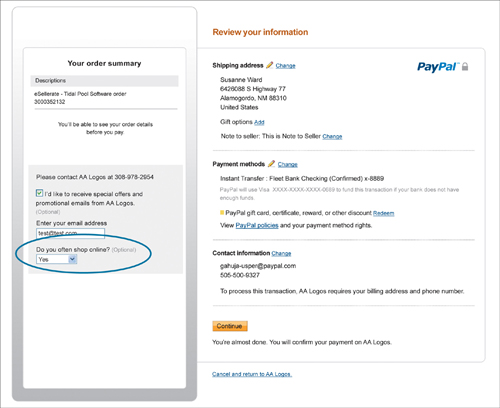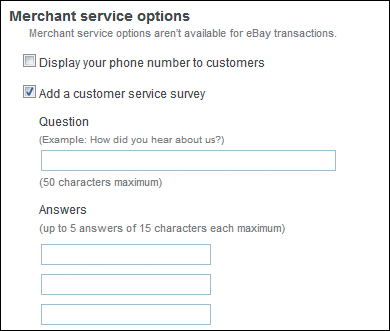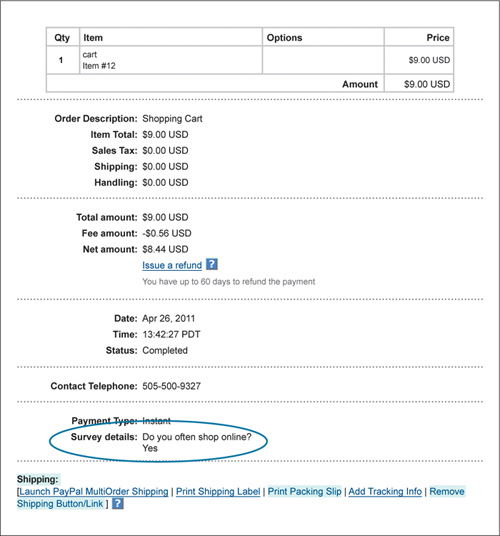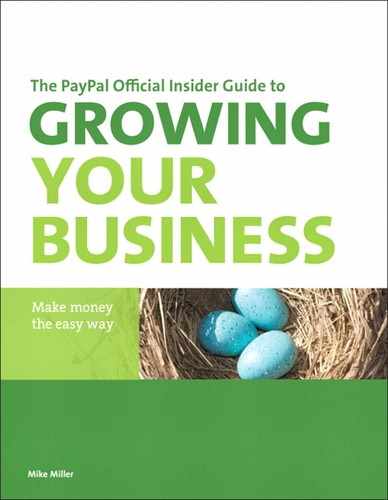14. Interacting with Your Customers

As you’ve learned throughout this book, PayPal offers many different products and services that help you manage and grow your business. But there’s even more help available—in the form of tools that let you more effectively interact with your customers.
This chapter discusses two items you can add to your checkout process through PayPal. You can add a survey question to your checkout process to gather information about your customers, and you can invite customers to sign up for promotional emails from your company.
Surveying Your Customers
To grow your business, you need to know what your customers are thinking. One of the easiest ways to do this is to just ask them—via an online survey.
PayPal makes it easy to conduct this sort of online survey. You simply add a survey question to your checkout confirmation page, where it’s integrated seamlessly into the PayPal checkout process. All the customer has to do is make a selection from a drop-down list—the process is not complicated or overly intrusive.
What Kind of Question Can You Ask?
PayPal lets you add a single survey question to the checkout confirmation page that all your customers see when purchasing from your site. Up to five possible answers appear in a drop-down menu, like the one shown in Figure 14.1. The customer answers the question by clicking an option from the list.
Figure 14.1. A typical survey question on a PayPal checkout confirmation page.

What kinds of questions, then, should you ask of your customers?
The most common survey question asked by PayPal merchants is how the customer heard about the merchant. This is a great way to find out which of your various promotional activities are working. Did the customer hear about you from an advertisement, another website, an email message, a Google search, a mention on Facebook or Twitter, or someplace else? It’s important to know where your customers are coming from.
You can also ask customers what other items they might be interested in. They bought (at least) one thing from you; what else might they like to purchase in the future?
For that matter, you can ask them what other types of products they’d like to see on your site. Or, perhaps, you could ask them what type of item they might be interested in purchasing next.
You can also use your survey question to find out what customers think of you. You could ask how satisfied they were with the shopping experience: very, somewhat, or not at all. Or you could ask about any improvements they might like to see for your site, or your business in general.
Other retailers use their survey question to ask demographic questions about their customers. You can ask the customers’ income level, level of schooling, profession, marital status, you name it. Just remember, you have only one question to ask, so make sure it counts!
Adding a Survey Question to Your Checkout Page
You can add a single survey question to the customer checkout page of any PayPal-hosted checkout solution. Your question can be up to 50 characters long, and have up to five possible answers, each up to 15 characters in length. The answers appear in a drop-down menu beside the question; the customer selects an option from the menu to answer the question.
To add a survey question to your checkout page, follow these steps:
1. Go to your profile and select My Selling Tools on the left.
2. Under the Selling Online heading, click to update your Custom Payment Pages.
Figure 14.2. Creating a PayPal survey question.

3. When the Customize Your Payment page appears, click the Options tab.
4. Under the Merchant Service Options heading, check the “Add a customer service survey” box.
5. The page now expands, as shown in Figure 14.2. Enter your survey question (50 characters maximum) into the Question box.
6. Enter your first three answers (each up to 15 characters in length) in the first three Answers boxes.
7. To enter up to two more answers (for a total of five), click the Add More Answers link, and then enter the additional answers in the new boxes.
8. Click the Save button when done.
For example, you might enter the question “How did you hear about us?” Then you might provide the following answers:
• Online ad
• Search engine
• Website or blog
• Other
Once you’ve activated the survey, your buyers will see it when they reach the Review & Complete page in the checkout process—the page they’re taken to after signing into PayPal. They have the option of answering or ignoring the question; it’s not a requirement to proceed to the next page.
Viewing Survey Results
When a customer completes your survey, you can view the results for that individual transaction. Just go to your account overview or History page, identify a particular transaction, and then click the Details link. On the following Transaction Details page, the Survey Details section (shown in Figure 14.3) displays the customer’s answer to your question.
At present, there’s no way to view a summary of survey results on the PayPal site. Instead, you can tabulate the results manually and then generate your own summary.
Figure 14.3. Viewing a customer survey response on the Transaction Details page.

Signing Up Customers for Email Promotions
As a retailer offering goods or services over the Internet, email marketing should be an essential part of promoting your business. That’s because email marketing is a type of direct marketing; it’s intended not simply to increase brand awareness or drive traffic to your website, but rather to solicit direct sales of a particular product or service.
An email marketing campaign involves sending targeted messages to your existing customer base; these emails can advertise upcoming promotions, new products, and the like. As such, you use email marketing to entice more sales from your current customers. And, as all marketers know, it costs a lot less to get more sales from a current customer than it does to create a new customer.
Smart merchants encourage their customers to sign up to receive their promotional emails. You can do this at any point in the purchase process, including on your checkout confirmation page. If you use PayPal for your checkout, you can let customers sign up for promotional emails on the checkout confirmation page itself.
To keep your promotional emails from being viewed as spam, ask your customers to opt in through an active sign-up process. Otherwise you’ll be sending out unsolicited—and unwanted—emails. Even if customers opt in, you might be flagged as spam unless you use a sending email address known to your customers (and their email service).
To add this option to your PayPal checkout confirmation page, the process is similar to that for adding a survey question. Follow these steps:
1. Go to your profile and select My Selling Tools on the left.
2. Under the Selling Online heading, click to update your Custom Payment Pages.
Figure 14.4. Adding email signup to your checkout page.

3. When the Customize Your Payment page appears, click the Options tab.
4. Under the Merchant Service Options heading, check the “Offer promotional emails” box, as shown in Figure 14.4.
5. Click the Save button.
Your customers can now sign up for your promotional emails during the checkout process. You can then use third-party software to send your customers a variety of emails to promote new products, upcoming sales, and the like. If you decide to pursue this, take the time to become familiar with email marketing regulations. And comply with them!
The Bottom Line
PayPal offers two features that help you more effectively interact with your customers. You can add a survey question to your PayPal checkout page, to better understand what your customers are thinking and experiencing. And you can offer customers the option of signing up for your email-based promotions and mailings. Both of these features are free, and available to any business using PayPal-hosted checkout services.
